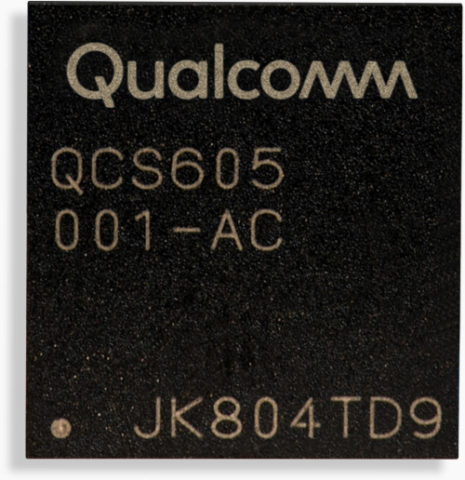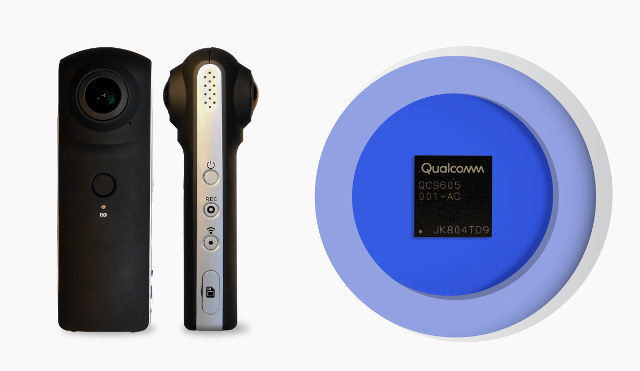Qualcomm has unveiled the “Qualcomm Vision Intelligence Platform”, which aims at IoT devices with cameras leveraging artificial intelligence and computer vision.
The first SoCs part of the platform are QCS605 and QCS603 manufactured with a 10nm process and equipped with an “advanced image signal processor” and the Qualcomm Artificial Intelligence (AI) Engine, as well Arm CPU cluster, Adreno GPU, and Hexagon DSP.

QCS603 & QCS605 specifications:
- CPU
- QCS603 – 2x 1.6GHz Qualcomm Kryo 300 Gold cores, 2x 1.7GHz Qualcomm Kryo 300 Silver cores
- QCS605 – 2x 2.5GHz Qualcomm Kryo 300 Gold cores, 6x 1.7GHz Qualcomm Kryo 300 Silver cores
- Qualcomm Artificial Intelligence Engine
- DSP
- Qualcomm Hexagon 685 Vector Processor
- 2x Qualcomm Hexagon Vector eXtensions (HVX)
- GPU – Qualcomm Adreno 615 with OpenGL ES 3.2, Vulkan, OpenCL support
- Neural Processing – Qualcomm Snapdragon Neural Processing Engine programming interface with support for Tensorflow, Caffe/Caffe2, ONNE, Android NN; 2.1 TOPS @ 1w
- DSP
- Memory I/F – 16-bit LPDDR4x @ up to 1866MHz
- Connectivity
- WiFi
- QCS603 – 802.11ac up to 867 Mbps , 802.11a/b/g, 802.11n; 1×1 MIMO
- QCS605 – 802.11ac Wave 2 up to 867 Mbps , 802.11a/b/g, 802.11n; 2×2 MU-MIMO
- Bluetooth 5.1 (? TBC)
- WiFi
- Location – GPS, GLONASS, Beidou, Galileo, QZSS, SBAS
- USB – USB 3.1
- Camera
- 2x Qualcomm Spectra 270 image sensor processor (14-bit)
- QCS603 – Up to 16 MP dual camera, up to 24 MP single camera
- QCS605 – Up to 16 MP dual camera, up to 32 MP single camera
- Video
- Video Capture
- QCS603 – Up to 720p @ 60 fps, up to 1080p @ 30 fps
- QCS605 – Up to 4K Ultra HD video capture @ 60 FPS, Up to 5.7K video capture @ 30 FPS,Up to 1080p video capture @ 60 FPS
- Video Playback – Up to 4K Ultra HD video playback with H.265 (HEVC), H.264 (AVC)
- Video Capture
- Display
- Up to Quad HD resolution
- External up to 4K Ultra HD
- Audio
- Qualcomm Aqstic audio codec and speaker amplifier (up to 4W) with Speaker Protection
- Qualcomm aptX Classic and HD
- Audio Playback up to 384kHz/32bit, up to 192kHz/24bit, DSD64 and DSD128 support
- Audio Recording up to 192kHz/24bit
- Power
- Accompanying PMIC
- QCS603 – PME605, PM8005
- QCS605 – PM670 or PM670L
- Charging – Qualcomm Quick Charge 4
- Accompanying PMIC
- Process Technology – 10nm LPE
QC603 is a quad-core processor, while QCS605 is an octa-core processor with high-performance “Gold” cores clocked higher. QCS605 also has better WiFi, supports up to 32MP single camera (vs 24 MP), 4K video recording (vs 720p60, 1080p30), and is paired with a different PMIC.
The SoC supports the most popular voice services including Amazon Alexa Voice Service, Microsoft Cortana, Baidu DuerOS, and Google Assistant.

Besides the chips themselves, the Vision Intelligence Platform also includes advanced camera processing software, machine learning, and computer vision software development kits (SDKs). The company can also provide QCS605-based VR 360 camera reference designs made by Altek Corporation, and QCS603-based industrial security camera reference designs should become available in Q2 2018
Target applications include industrial and consumer smart security cameras, sports cameras, wearable cameras, virtual reality (VR) 360 and 180 cameras, robotics, smart displays, and more.
Qualcomm QCS605 and QCS603 are sampling now with multiple SKUs to match various technical and cost requirements. Two of the first companies to implements QCS60x chips into their products will be KEDACOM and Ricoh THETA. You’ll find more details on Qualcomm’s Vision Intelligence Platform product page.

Jean-Luc started CNX Software in 2010 as a part-time endeavor, before quitting his job as a software engineering manager, and starting to write daily news, and reviews full time later in 2011.
Support CNX Software! Donate via cryptocurrencies, become a Patron on Patreon, or purchase goods on Amazon or Aliexpress




